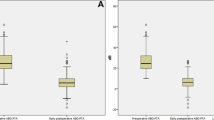Abstract
This study investigate the effect of stapes surgery on bone conduction (BC) improvement in otosclerotic patients with mixed hearing loss and also compare the effect of three different types of surgery (complete stapedectomy, partial stapedectomy and microfenestration stapedotomy) on this improvement. We retrospectively reviewed surgical database of 84 otosclerotic patients with mixed hearing loss. Sixty-two patients (75%) had significant improvement in BC after surgery (P = 0.03). In 85% of patients with follow-up time longer than 1 year, this improvement had remained. Improvement in BC after surgery was better in partial stapedectomy group (82.6%) and complete stapedectomy group (80.8%) in comparison with microfenestration stapedotomy group (63%) (P = 0.052).

Similar content being viewed by others
References
Aarnisalo AA, Vasama JP, Hopsu E, Ramsay H (2003) Long-term hearing results after stapes surgery: a 20-year follow-up. Otol Neurotol 24:567–571. doi:10.1097/00129492-200307000-00006
Arnoldner C, Schwab B, Lenarz T (2006) Clinical results after stapedotomy: a comparison between the erbium: yttrium-aluminum-garnet laser and the conventional technique. Otol Neurotol 27:458–465. doi:10.1097/00129492-200606000-00005
Awengen DF (1993) Change of bone conduction thresholds by total footplate stapedectomy in relation to age. Am J Otolaryngol 14:105–110. doi:10.1016/0196-0709(93)90048-C
Carhart R (1950) Clinical application of bone conduction audiometry. Arch Otolaryngol 51:798–808
Dornhoffer JL, Bailey HA Jr, Graham SS (1994) Long-term hearing results following stapedotomy. Am J Otol 15:674–678
Glasscock MEIII, Shambaugh GE Jr (2002) Surgery of the Ear, 5th edn. W. B. Saunders, Philadelphia
House JW, Cunningham CDIII (2005) Otosclerosis. In: Cummings CW (ed) Otolaryngology head and neck surgery, 4th edn. Mosby, Philadelphia
Langman AW, Jackler RK, Sooy FA (1991) Stapedectomy: long-term hearing results. Laryngoscope 101:810–814. doi:10.1288/00005537-199108000-00002
Lebo CP, Reddell RC (1972) The presbyacusis component in occupational hearing loss. Laryngoscope 82:1399–1409. doi:10.1288/00005537-197208000-00002
Lippy WH, Burkey JM, Schuring AG, Rizer FM (1997) Stapedectomy in patients with small air-bone gap. Laryngoscope 107:919–922. doi:10.1097/00005537-199707000-00016
Moscillo L, Imperiali M, Carra P, Catapano F, Motta G (2006) Bone conduction variation poststapedotomy. Am J Otolaryngol 27:330–333. doi:10.1016/j.amjoto.2006.03.002
Quaranta N, Besozzi G, Fallacara RA, Quaranta A (2005) Air and bone conduction change after stapedotomy and partial stapedectomy for otosclerosis. Otolaryngol Head Neck Surg 133:116–120. doi:10.1016/j.otohns.2005.03.011
Rizer FM, Lippy WH (1993) Evolution of techniques of stapedectomy from the total stapedectomy to the small fenestra stapedectomy. Otolaryngol Clin North Am 26:443–451
Schick F (1992) Alterations of bone conducted hearing in cases of modified middle ear mechanics. Eur Arch Otorhinolaryngol 249:268–272. doi:10.1007/BF00714490
Tonndorf J (1994) Bone conduction hearing. In: Keidel WD, Neff WD (eds) Handbook of sensory physiology. Springer, Berlin, pp 172–247
Vincent R, Sperling N (2006) Surgical finding and long-term hearing results in 3050 stapedectomies for primary otosclerosis. Otol Neurotol 27(8 Suppl 2):S25–S47. doi:10.1097/01.mao.0000235311.80066.df
Wiet RJ, Raslan W, Shambaugh GE (1986) Otosclerosis 1981 to 1985. Our four-year review and current perspective. Am J Otol 7:221–228
Author information
Authors and Affiliations
Corresponding author
Rights and permissions
About this article
Cite this article
Karimi Yazdi, A., Sazgar, A.A., Motiee, M. et al. Improvement of bone conduction after stapes surgery in otosclerosis patients with mixed hearing loss depending from surgical technique. Eur Arch Otorhinolaryngol 266, 1225–1228 (2009). https://doi.org/10.1007/s00405-009-0918-7
Received:
Accepted:
Published:
Issue Date:
DOI: https://doi.org/10.1007/s00405-009-0918-7




